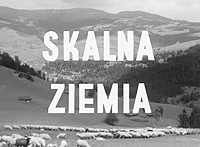 Skalna ziemia
Skalna ziemia
Poland, 1956, black and white, 16 mins
Many of the films in the ‘black series’ of Polish documentaries from 1955-58 sought to expose the reality behind the official rhetoric, and Rocky Soil offers a particularly good example. Set in and around the rural hamlet of Gorce, the film’s unnamed protagonist (and first-person narrator, though the latter role was taken by actor Miecysław Stoor) is an idealistic doctor who is trying to bring the benefits of up-to-date and seemingly well-funded medical technology to a population that distrusts and fears them. Even the doctor’s motorbike seems out of place in a peasant society that hasn’t changed much since the 1850s.
The first thing he has to do is counter a widespread popular belief that the best thing to do with sick children is to lock them away to stew in their own germs. Health advice and invitations to attend his clinic are broadcast on public loudspeakers, but overheard conversations reveal the scale of the opposition, fuelled by ignorance, rumour and dubious logic (“My little Ewa died three months after weighing, so weighing must be harmful”). Even a 50% infant mortality rate in one family is accepted as just one of those things. The doctor’s well-meaning lecture about growing vegetables for vitamins is ignored by women more interested in beating the dirt out of their wet clothes in a fast-flowing river. (The film is packed with similar shots of local colour, and although the doctor was played by an actor, the villagers are almost certainly the genuine articles.)

But some of the inhabitants are eventually persuaded to venture through the doors of the nearby Kamienica medical centre, whose white walls must have looked unnervingly pristine to their eyes. While their attendance shows that the first stage of their distrust has been conquered, the doctor still faces challenges to his authority: one patient refuses to take medicine because the local healer has said it will do him no good. (“Obviously, the healer is always wider than a doctor”, the latter acknowledges ruefully). Vocabulary is a problem, as the locals are vague or evasive about their specific ailments, so time-consuming top-to-toe medical check-ups become the norm. During these, the doctor sometimes finds evidence of less expert “treatment” – an elderly man covered up a carbuncle with resin, causing a major infection. Warned that this sort of thing might kill him, he interprets it as a threat, and flees (through a cemetery studded with large wooden crosses).
One night, the doctor is visited by one of the locals, to tend to a sick child in the mountain retreat of Chotnice. The doctor complains that they only call him at the last minute, and never articulate the precise problem – and, in another neat touch of black comedy, they summon the priest at the same time. After a three-hour journey in an open cart in the pouring rain, he finds that the boy has been seriously ill for ten days, being treated for “inflammation” (it’s actually diphtheria) by his grandmother. Her hands still covered with manure from her daily farming chores, she is convinced that blowing on his face will somehow help. The precise nature of the herbal remedy she’s boiling up is never explained: the doctor finds her attempting to pour it down the hapless youngster’s throat when he arrives. In the event, though, only the priest’s services are required: all the doctor can do is pre-emptively inoculate the child’s siblings and hope for the best.

The doctor’s commentary becomes increasingly weary at this point, bemoaning the sheer scale of his task, and how nothing in his training prepared himself for these situations. But on the way home, he meets Kasia, a young girl who initially had to be forced into hospital with the aid of the militia, but who is now in the peak of health. It’s a small but potent victory – as he puts it, “how little is necessary for a man to regain self-esteem: one smile of a child is enough for a whole day”. Compared with the bleak despair that suffuses most of the other ‘black series’ documentaries, it’s a surprisingly upbeat conclusion – as well as an implicit rebuke to those in authority who think that drastic changes can be implemented overnight.
- Director: Włodzimierz Borowik
- Script: Włodzimierz Borowik, Marcin Goląb
- Camera: Antoni Staśkiewicz
- Editor: Maria Orlowska
- Sound: Bohdan Jankowski
- Commentary Text: Karol Malcużyński
- Narration: Miecysław Stoor
- Production Manager: Andrzej Liwnicz
- Production Company: Wytwórnia Filmów Dokumentalnych (Documentary Film Studio)
The film is included on PWA’s Polish School of the Documentary: The Black Series double-DVD set (Region 0 PAL). Aside from a spot of damage around the central reel change, the print is in very good physical condition, with an contrast range that’s appreciably wider than many of the films in the ‘black series’. The soundtrack is 1950s mono, but no worse than expected, and the optional English subtitles are generally presented to a higher standard than with many of the films on this DVD.